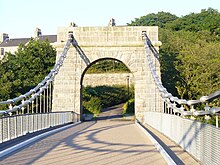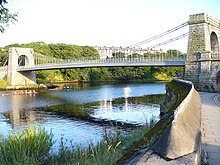
A suspension bridge is a type of bridge in which the deck is hung below suspension cables on vertical suspenders. The first modern examples of this type of bridge were built in the early 1800s. Simple suspension bridges, which lack vertical suspenders, have a long history in many mountainous parts of the world.

The River Dee Ferry Boat Disaster occurred on 5 April 1876. Thirty two people drowned in the mouth of the River Dee, Aberdeenshire, Scotland when their ferry boat capsized. Overcrowding, fast flowing current and a poorly spliced wire rope were blamed.

Torry is an area within the city of Aberdeen, Scotland.
The city of Aberdeen, Scotland, contains a number of areas and suburbs, some of which are historically separate settlements that have been absorbed by the expanding city.

The network of transportation in Aberdeen is widespread and complex like that of any major city. It is currently receiving the attention of politicians in Scotland who have acknowledged that there has been underinvestment over the past few decades in keeping the infrastructure in line with the needs of the city.
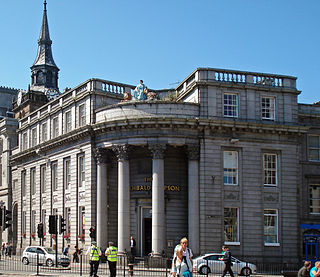
The architecture of Aberdeen, Scotland, is known for the use of granite as the principal construction material. The stone, which has been quarried in and around the city, has given Aberdeen the epithet The Granite City, or more romantically, and less commonly used, the Silver City, after the mica in the stone which sparkles in the sun.
The Politics of Aberdeen, Scotland have changed significantly in recent years. In 1996, under the Local Government etc. (Scotland) Act 1994, Grampian Regional Council and Aberdeen District Council were dissolved, creating the new unitary Aberdeen City Council to represent the city's council area.
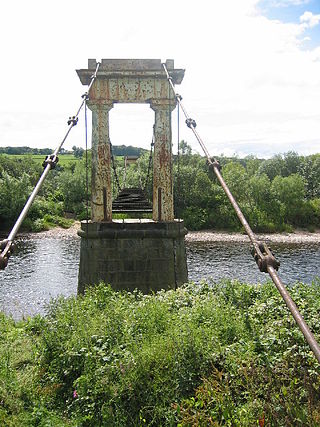
St. Devenick's Bridge is a disused suspension footbridge which crosses the River Dee from Ardoe to Cults near Aberdeen in Scotland.

The Bridge of Dee or Brig o Dee is a road bridge over the River Dee in Aberdeen, Scotland. The term is also used for the surrounding area of the city. Dating from 1527, the bridge crosses at what was once the City of Aberdeen's southern boundary.
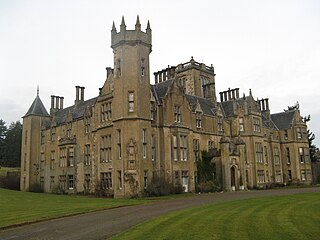
John Smith was a Scottish architect. His career started in 1805 and he was appointed as the official city architect of Aberdeen in 1807, the first person to hold this post. Together with Archibald Simpson, he contributed significantly to the architecture of Aberdeen, and many of the granite buildings that gave the city the nickname 'The Granite City' or also 'The Silver City' are attributed to them.

Nigg is an area of Aberdeen, Scotland, south of the River Dee. It has a population of 16,500. The area has a bay known as the Bay of Nigg or Nigg Bay, immediately south of a coastal golf course, and a farm that is also a visitor attraction, known as Doonies Farm.

James Abernethy FRSE was a Scottish civil engineer.
Aberdeen Ferryhill railway station was the temporary terminus of the Aberdeen Railway and the first railway station to serve the city of Aberdeen. Regular passenger service began on 1 April 1850. As the station is located some distance south of the city centre, omnibuses and luggage vans were employed to complete the journey into the city. In 1853, the Deeside Railway was opened, which also used Ferryhill as a terminus. In 1854, the railway was extended and a new terminus, Aberdeen Guild Street railway station, was opened on 2 August. This station was located closer to the city centre, approximately where the present-day Aberdeen railway station was later built.

Aberdeen Harbour, rebranded as the Port of Aberdeen in 2022, is a sea port located in the city of Aberdeen on the east coast of Scotland. The port was first established in 1136 and has been continually redeveloped over the centuries to provide a base for significant fishing and ship building industries. Since the 1970s it has provided support to the offshore oil and gas industry operating in the North Sea and it is the main commercial port in the north east of Scotland.
Events from the year 1830 in Scotland.

The 2017 Aberdeen City Council election took place on 4 May 2017 to elect members of Aberdeen City Council. The election used the 13 wards created as a result of the Local Governance (Scotland) Act 2004, with each ward electing three or four Councillors using the single transferable vote system a form of proportional representation, with a total of 45 Councillors elected, an increase in two members from 2012.

The Cambus O' May bridge spans the River Dee to the east of Ballater, Aberdeenshire, Scotland. It was paid for by the estate of Alexander Gordon, who had grown up nearby. The bridge was built in 1905 and is a suspension footbridge 164 feet (50 m) long and 4 feet (1.2 m) wide. The bridge was rebuilt in 1988 for safety reasons but was badly damaged in the December 2015 Storm Frank. It was repaired and reopened in April 2021.
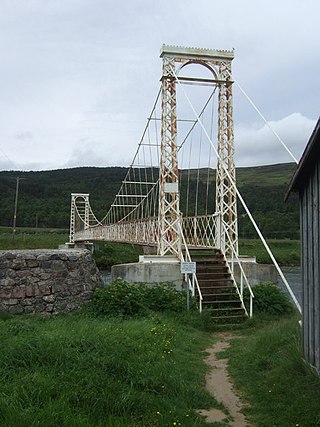
The Polhollick Bridge spans the River Dee near Ballater, Aberdeenshire. It was built in 1892 by James Abernethy, a steel founder in Aberdeen. The bridge had been commissioned by Alexander Gordon as a gift to the area to replace a ferry crossing. Gordon had grown up in the area and witnessed a drowning incident at the ferry. It is a suspension bridge for pedestrians only. The bridge is similar to the nearby Cambus O' May bridge also paid for by Gordon. The bridge suffered severe damage during Storm Frank in December 2015 and reopened after repairs in December 2018.
